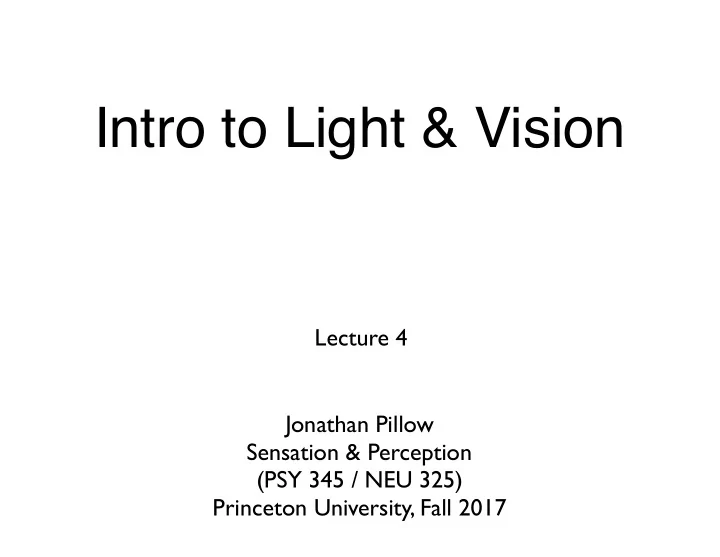

Intro to Light & Vision Lecture 4 Jonathan Pillow Sensation & Perception (PSY 345 / NEU 325) Princeton University, Fall 2017
(Chapter 1 leftovers)
Figure 1.16 Detecting a stimulus using the signal detection theory (SDT) approach (Part 2)
d-prime - measure of sensitivity
Figure 1.18 For a fixed d ʹ , all you can do is change the pattern of your errors by shifting the response criterion
Signal Detection Theory Terms to know: “noise” distribution : values arising when stimulus not present “signal” distribution : values arising when signal + noise present Type I error : rate of “false alarms”, or false positives Type II error : rate of “misses”, or false negatives psychometric function : describes probability of saying “I heard it” as function of stimulus intensity
Summary • Weber-Fechner law • Stevens’ power law • psychophysics • psychometric function • signal detection theory: threshold, criterion, Hit/ Miss, FA/CR, d’ = d-prime • brain regions, spikes, synapses, neurotransmitter
Chapter 2: First steps in Vision
Light : electromagnetic radiation within a narrow energy range • a wave: can be bent by lenses • a particle: “photons” - can travel through a vacuum, have minimum energy that can be emitted/absorbed (quanta) • Light: A wave; a stream of photons, tiny particles that each consist of one quantum of energy
Food for thought : Why are we sensitive to such a narrow range of the electromagnetic spectrum? Other solutions are possible: • bees: ultraviolet light • pit vipers: infrared light
What happens to light? • Absorbed : Energy (e.g., light) that is taken up, and is not transmitted at all • Scattered : Energy that is dispersed in an irregular fashion (most light does this!)
What happens to light? • Refracted : Energy that is altered as it passes into another medium, (e.g., light entering water from the air) • Reflected : Energy that is redirected when it strikes a surface
Light Physics What it all looks like. (Messy!) • each point in space has light from all angles passing through it
Why do we need optics? • without optics, light from object screen everything hits the whole retina/screen/film • with optics, we form an pinhole camera image • i.e. light from a single point image in space hits a single spot on the retina
Pinhole camera: problem of pinhole size smaller aperture = fewer rays = sharper image = dimmer image
Some pinhole images why? big pinhole small pinhole tiny pinhole
diffraction • bending of waves around small obstacles or through small apertures slit = 1 x wavelength slit = 5 x wavelength
the eye (viewed from above)
• Cornea : The transparent “window” into the eyeball (carries 2/3 of eye’s total refractive power) • Aqueous humor : watery fluid in behind cornea • Lens : allows changing of focus • Pupil : The dark circular opening at the center of the iris in the eye, where light enters the eye • Vitreous humor : transparent fluid that fills main cavity of the eye (gel-like; may contain “floaters”) • Retina : light-sensitive membrane in the back of the eye that contains rods and cones.
Recommend
More recommend